 A three-year excavation of Pit One in the mausoleum complex of Qin Shi Huang (259 B.C.–210 B.C.), the first emperor of a unified China, has uncovered more than 100 new terracotta warriors, 12 horses, two chariots and hundreds of accessories, including war drums and the first shield of its kind ever found in the four main pits of the complex. This is the third excavation since the first warriors were discovered by farmers digging a well outside the city of Xi’an, Shaanxi province, central China in 1974, and most of the estimated 8000-strong army is still buried.
A three-year excavation of Pit One in the mausoleum complex of Qin Shi Huang (259 B.C.–210 B.C.), the first emperor of a unified China, has uncovered more than 100 new terracotta warriors, 12 horses, two chariots and hundreds of accessories, including war drums and the first shield of its kind ever found in the four main pits of the complex. This is the third excavation since the first warriors were discovered by farmers digging a well outside the city of Xi’an, Shaanxi province, central China in 1974, and most of the estimated 8000-strong army is still buried.
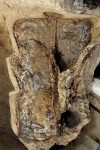 The shield is an impressive 28 inches high and 20 inches wide and decorated with red, green and white geometric patterns. Discovered on the right of one of the chariots, the shield probably belonged to an official of high rank. A bronze shield and chariot were found during the 1980 excavation, but the bronzes are half the size of the terracotta warriors. Archaeologists think the newly discovered shield is life-sized, an accurate depiction of Qin Dynasty (221 B.C.-206 B.C.) shields.
The shield is an impressive 28 inches high and 20 inches wide and decorated with red, green and white geometric patterns. Discovered on the right of one of the chariots, the shield probably belonged to an official of high rank. A bronze shield and chariot were found during the 1980 excavation, but the bronzes are half the size of the terracotta warriors. Archaeologists think the newly discovered shield is life-sized, an accurate depiction of Qin Dynasty (221 B.C.-206 B.C.) shields.
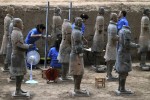 The 100+ newly-discovered figures contain great rarities and new information as well. Eight of them are officials, identifiable as such from their more elaborate, more delicately patterned armor. Much more of the original paint has survived on these new warriors than on any previously discovered. Every figure in the massive army was initially painted with raw lacquer, a technique that doesn’t stand the test of time very well. The lacquer pulls away from the terracotta surface, flaking off and fading. Some of the warriors were put under even more stress by water and fire during the millennia.
The 100+ newly-discovered figures contain great rarities and new information as well. Eight of them are officials, identifiable as such from their more elaborate, more delicately patterned armor. Much more of the original paint has survived on these new warriors than on any previously discovered. Every figure in the massive army was initially painted with raw lacquer, a technique that doesn’t stand the test of time very well. The lacquer pulls away from the terracotta surface, flaking off and fading. Some of the warriors were put under even more stress by water and fire during the millennia. 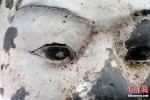 Most of the figures that still had color attached when they were unearthed in the 1970s quickly shed it once they were exposed to the air.
Most of the figures that still had color attached when they were unearthed in the 1970s quickly shed it once they were exposed to the air.
The colors are far better preserved this time, still brilliant in hue and showing the amazing detail work artisans did to make every figure have its own distinctive look. They have different colored eyes and different flesh tones, and one of the heads even has delicate little eyelashes still clearly visible.
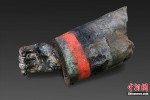
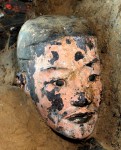

Pit 9901, a smaller site in the southeast area of the tomb complex that archaeologists only started excavating last August, has produced a fascinating set of 20 figures that appear to be non-military, likely performers intended to keep the emperor entertained in the afterworld. They aren’t wearing armor and they strike curious poses: one holds his left arm with his right hand, one is crouched. They stand face to face, portly figures looking south and slender figures looking north.
 One of the Pit 9901 pieces stands literally head and shoulders above the others. He was found missing his head, but his remaining body from neck to toe is 7’3″ tall. His feet alone are over 12″ long. Assuming a proportional head, when complete this figure was 8’2″ tall.
One of the Pit 9901 pieces stands literally head and shoulders above the others. He was found missing his head, but his remaining body from neck to toe is 7’3″ tall. His feet alone are over 12″ long. Assuming a proportional head, when complete this figure was 8’2″ tall.
Archaeologists have also discovered additional evidence that the figures were deliberately burned and broken in antiquity. The warriors were found in pieces, some of them with their clay melted and misshapen. There is charcoal residue and white ash in some of the pits, signs of a high temperature fire deliberately set using organic materials like wood and hemp ropes. 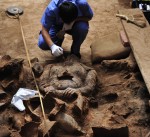 That puts the dates of the fires close to the time of burial because if they had been set by looters centuries later, the organic kindling would have been too decayed to turn to charcoal. The fires do not appear to have been set as part of a burial ritual because only a few of the pits were burned.
That puts the dates of the fires close to the time of burial because if they had been set by looters centuries later, the organic kindling would have been too decayed to turn to charcoal. The fires do not appear to have been set as part of a burial ritual because only a few of the pits were burned.
The primary arson suspect is Xiang Yu, a general who along with other ambitious war leaders and would-be kinglets rebelled against Emperor Qin Shi Huang’s son Qin Er Shi in 209 B.C. Xiang Yu was reputed to have been particularly ruthless, slaughtering entire cities even after they surrendered to him and burning down every palace he encountered. He defeated the Qin army in 207 B.C., burying them all alive after they surrendered. According to several ancient Chinese historians, after his victory Xiang Yu looted and burned Qin Shi Huang’s mausoleum. He wasn’t kind to his allies either, setting them up for assassination and backstabbing them regularly.
 On the pro side, he did give himself a pretty awesome title, Hegemon-King of Western Chu, and according to ancient historian Sima Qian (ca. 135 B.C.–86 B.C.) he composed a song lamenting his impending defeat at the Battle of Gaixia in 202 B.C. He also apparently had a double pupil in one eye which was part of his mystique as a king and sage. Last but certainly not least, he makes an appearance in War Stories, one of the greatest Firefly episodes, in which Xiang Yu’s writings on torture are a recurring theme raised by both Shepherd Book and the crime boss/torturer Niska.
On the pro side, he did give himself a pretty awesome title, Hegemon-King of Western Chu, and according to ancient historian Sima Qian (ca. 135 B.C.–86 B.C.) he composed a song lamenting his impending defeat at the Battle of Gaixia in 202 B.C. He also apparently had a double pupil in one eye which was part of his mystique as a king and sage. Last but certainly not least, he makes an appearance in War Stories, one of the greatest Firefly episodes, in which Xiang Yu’s writings on torture are a recurring theme raised by both Shepherd Book and the crime boss/torturer Niska.